Lerato Shadi, Mabogo Dinku (2019)
Leticia Obeid. Jano (2015)
Reah Storr. Junkanoo Talk, 2017 (Conversación junkanoo)
Ailbhe ni Bhriain. Inscriptions (One Here Now), 2018 [Inscripciones (una aquí ahora)]
Bojan Fajfrić. The Cause of Death, 2015 (La causa de muerte)
Miguel Fernández de Castro. Grammar of Gates, 2019 (Gramática de las puertas)
Lisa Tan. My Pictures of You, 2017-2019 (Mis fotos de vos)
Francesco Pedraglio. Racconto antiorario (6 costellazioni), 2017 [Historia en sentido antihorario (6 constelaciones)]
Dominka Olszowy. Wanda Wanton, 2016
Raqs Media Collective. Passwords for Time Travel, 2017 (Contraseñas para un viaje en el tiempo)
Mohamed A. Gawad. Betalpha (Balbalah), 2018
Yu Guo. Jiéjiè , 2019 (Encantamiento)
Evgeny Granilshchikov. Courbet's Funeral, 2014 (El funeral de Courbet)
Yao Qingmei. Sanzu Ding and its Patterns: A major archeological discovery, 2013-actualidad (Sanzu Ding y sus patrones: Un gran descubrimiento arqueológico)
Ergin Çavuşoğlu. Desire Lines (Tarot & Chess), 2016 [Líneas de deseo (Tarot y ajedrez)]
Lerato Shadi, Mabogo Dinku (2019)
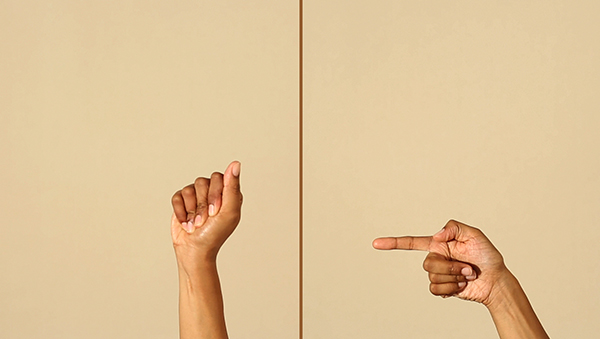
Lerato Shadi’s work challenges common assumptions to critique Western notions of history and make visible that which is invisible or overlooked. In particular, she critiques the assumption that Western history is world history. In the video, the artist’s hand makes enigmatic gestures and she sings a folk verse in a South African language. But she provides no subtitles or guidance on what the words and gestures mean because she is narrating the un-narratable, the history of her people, marginalised during apartheid South Africa. The history she was taught at school is the history of the coloniser, which she rejects, so what history can she tell? Furthermore, the translation of the language into English or other dominant western language would pay homage to western languages as the “universal” one, continuing the boxing in of others’ mother tongues into the languages of the “other”.
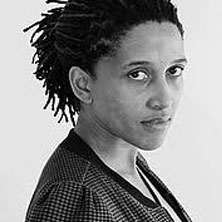 Lerato Shadi was born in Mahikeng, South Africa, and lives and works in Berlin. She graduated from the University of Johannesburg in 2006 and earned a MA in Spatial Strategies from the Weißensee Academy of Art in Berlin. Shadi works across video, performance and installation, often employing repetitive processes. Her work has been included in international exhibitions, most recently at the 14th Curitiba Biennal in Brazil; Zeitz MOCAA in Cape Town. She has been awarded the Alumni Dignitas Award of the University of Johannesburg in 2016, the Villa Romana Prize in 2018, and the Berliner Senat Arbeitsstipendium in 2019. Her work is in the collection of Tate, London, n.b.k. Videoforum, Berlin and Iziko South African National Gallery.
Lerato Shadi was born in Mahikeng, South Africa, and lives and works in Berlin. She graduated from the University of Johannesburg in 2006 and earned a MA in Spatial Strategies from the Weißensee Academy of Art in Berlin. Shadi works across video, performance and installation, often employing repetitive processes. Her work has been included in international exhibitions, most recently at the 14th Curitiba Biennal in Brazil; Zeitz MOCAA in Cape Town. She has been awarded the Alumni Dignitas Award of the University of Johannesburg in 2016, the Villa Romana Prize in 2018, and the Berliner Senat Arbeitsstipendium in 2019. Her work is in the collection of Tate, London, n.b.k. Videoforum, Berlin and Iziko South African National Gallery.
Leticia Obeid. Jano (2015)
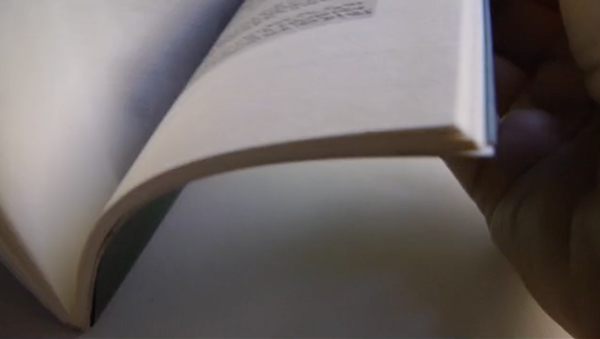
Leticia Obeid. Jano (2015), video 2’25’’. Seleccionada por Fundación Proa, Buenos Aires
Janus was, in Roman mythology, a two-faced god: one face looking to the past and the other to the future. Janus was the god of doorways, beginnings and endings. In this series, the book ́s page behaves like Janus, going from past to future of a text or vice versa. Jano is the attempt to revise the minimum portion of time that can be frozen in movement, through image.

Leticia Obeid was born in Córdoba, Argentina, en 1975. She lives and works in Buenos Aires. She studied painting at the School of Arts of Universidad Nacional de Córdoba (UNC), and received a scholarship from the Fundación Antorchas between 2003 and 2005 for additional training in video. She has been an artist in residence at the Atlantic Center for the Arts, USA; Cité Internationale des Arts, Paris, France, and Casa Vecina, Mexico City.
Her work has been shown in exhibitions and audiovisual projections in Argentina and internationally: Reverberations: art and sound in the MUAC collection, Mexico City; Focus Argentina, ARCO, Madrid (2017); Poéticas Políticas, Parque de la Memoria, Buenos Aires; International Short Film Festival, Oberhausen, Germany; Sights and sounds: highlights, Jewish Museum, New York (2016); Lo contrario de la magia, MALBA, Buenos Aires (2014); The Right to the City, Stedelijk Museum, Amsterdam (2013); The Life of Others. Repetition and Survival, Akbank Art Center, Istanbul (2013); Entre siempre y jamás, Latin American Pavilion, 54th Biennale di Venezia (2011); Conversas, 6th Bienal del Mercosur, Portoalegre (2007). She has published the novels Frente, perfil y llanura (Ed. Caballo Negro, Córdoba, 2013) and Preparación para el amor (Ed. Caballo Negro, Córdoba, 2015) and the monographic book Leticia Obeid. To write, to read, to listen, Blatt&Rios, 2015 (bilingual edition).
Artists' Q&A
Where are you from and how did you become interested in moving image work?
I am from Córdoba, Argentina, and I started making video in 2001 because it united all my interests of the moment: language, performance, sound, image, narration. It has fascinated me ever since. I really like filming and editing.
What inspired/influenced you to make Janus?
Jano was part of a process of mourning and my interest in thinking if time could go back. I was trying to capture the second where a page can go back, reversing the narration.
Where does the work fit into your wider practice and concerns?
All my work revolves around language, words, reading, the act of writing, and translation between images and words. Janus is a synthesis of all this.
During the current climate, how are you maintaining your art practice from home?
Quarantine allows me times of concentration and connection with ideas, readings and questions that I find inspiring. Despite the anguish, it has been quite a productive time for me.
What are you exploring/experimenting with during this time?
I am manually copying manuscripts from writers that I admire. It is an act of repetition, almost like a meditation, and a search too.
 www.leticiaobeid.com
www.leticiaobeid.com
twitter: leticiaobeid@nuevamelusina
Ig: leticiaobeid@nuevamelusina
fb: Leticia Obeid
© Catalina Bartolomé
Selection of images of recent works

Leticia Obeid. Huxley: Mensaje final, 2020. Ink on paper, 21,8 x 15cm

Leticia Obeid. Jane Austen: Cuentas, 2020. Ink on paper, 20,8 x 29,5 cm
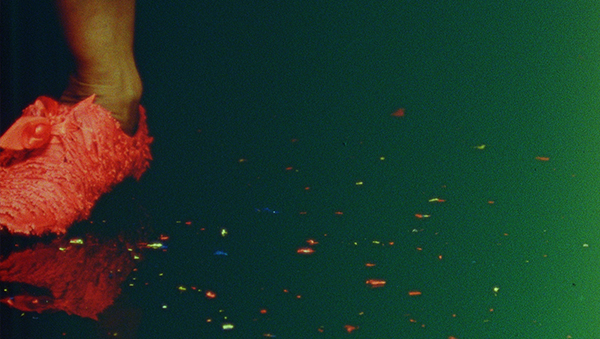
Reah Storr. Junkanoo Talk, 2017. Digital y super 16 mm convertido a digital, sonoro, 12’. Selected by Whitechapel Gallery, London
The Adequate Language must be both culturally specific and engage universally.
Junkanoo Talk investigates the language of celebration through carnival. It employs the techniques of costume crafting particular to Junkanoo - a carnival of the Bahamas. The sound is produced on the body and takes the rhythms of Rake 'n' Scrape music, also particular to the Bahamas. James Baldwin is quoted, speaking of the complexities of being an African American living in France, along with the Bahamian Tourism Minister who speaks of appropriation and the body as a voice.
Colour is coded in a way which suggests an internal logic, the layering on of a costume comparative to the layering on of a language. The film seeks a near forensic way of looking, yet the viewer is systematically denied the full picture. What is concealed or revealed is carefully orchestrated in order to facilitate a questioning of carnival. The body is considered a highly abstracted mediator to confront an identity politics which is in between. Authored by an artist of mixed race, Junkanoo Talk questions the slippages which occur when a language performs across cultures, asking what can be translated and where resistances occur.
Rhea Storr (b. 1991, Leeds, UK) is an artist based in London. Her practice spans moving image, drawing and writing. She received an MA in Contemporary Art Practice from the Royal College of Art (2017) and a BFA from The Ruskin School of Drawing and Fine Art, University of Oxford (2013). She makes work about black and mixed-race identities, asking where images fail or resist us. She often works on 16mm film. Recent screenings include National Museum of African American History and Culture, US, European Media Art Festival, Hamburg International Short Film Festival, Kassel Doc Fest, Berwick Film and Media Art Festival and Aesthetica Short Film Festival. She is the winner of the inaugural Louis Le Prince Experimental Film Prize and teaches workshops at the film co-operative Not Nowhere.
Ailbhe ni Bhriain. Inscriptions (One Here Now), 2018
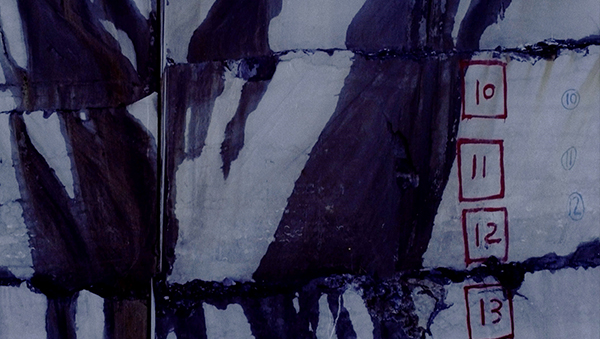
Ailbhe ni Bhriain. Inscriptions (One Here Now), 2018 [Inscripciones (una aquí ahora)]. Video monocanal, 14’54’’. Selected by Crawford Art Gallery, Cork (Irlanda)
Inscriptions (One Here Now) by Ailbhe Ní Bhriain combines film and computer generated imagery to create a world of dreamlike disorientation. Filmed within the negative space of a quarry interior, a series of extended tracking shots draw us into the quarry’s vertiginous depths. Punctuating these shots are scenes from an operating limestone factory, depicted in an abandoned and flooded state and inhabited by a lone monkey and various birds of prey.
Embedded within the film are references to the ancient Irish language of Ogham, a script which took the form of linear strokes cut into vertical standing stones. The camera in Inscriptions (One Here Now) attempts to ‘read’ the quarry walls. It traces the deep-time of geological sequences, the scars left by machinery on the rock surfaces, and the sprayed industrial notations that codify the commodification and disappearance of landscape. In these disparate forms of inscription it finds a metaphor for the Anthropocene - the current geological era in which human behavior is the dominant force shaping environment and climate. The animals in the film (all endangered species) survey their vanishing surroundings and look back at the viewer. They remind us perhaps of an alternative, ancient relationship with the natural world - a mode of perception and communication at risk of being lost forever.
Integral to the work is the layered soundtrack, described by composer Susan Stenger as a ‘sonic geology’ and developed from a study of the patterns of Morse code and the traditional tunes and phrases of Irish keening. The resulting music is a melodic lament immersed in a grounding of deep drones and atmospheres. Its method of composition mirrors the journey of the film, moving through a matrix of contradictory codes to access a deeper, wordless act of mourning. This film was originally commissioned by Miranda Driscoll as part of One Here Now, The Brian O’Doherty/ Patrick Ireland Project, supported by the Arts Council of Ireland.
Ailbhe Ní Bhriain (b. 1978) is an Irish artist known for her use of film, computer generated imagery and photography. Her work has shown widely, with exhibitions and screenings at RHA, Dublin; Broad Museum, Michigan; Domobaal, London; Paris Photo; Reina Sofia Museum Museum, Madrid; Caixa Forum, Barcelona; Centre of Contemporary Art, Thessaloniki; and Centrale, Brussels among others. She is represented by domobaal gallery, London
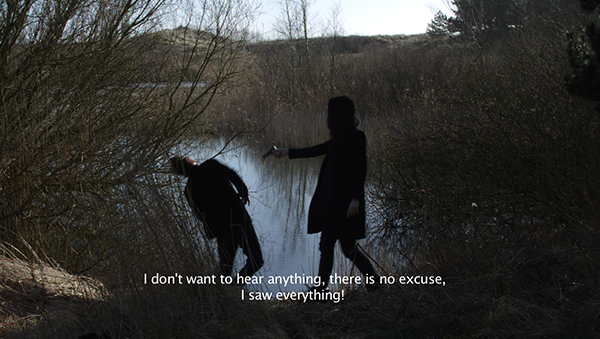
Bojan Fajfrić. The Cause of Death, 2015 (La causa de muerte). Video, 13’. Colección October Salon. Presented by Belgrade Cultural Centre, Serbia.
The Cause of Death is positioning the "Black Wave" of Yugoslav cinema at the center of social change, revives the legacy of this movement through examining the possibility of the language of art to stimulate systemic turns. The artist is appropriating texts and actions from Yugoslav film history and inserting them into the settings and conditions of his personal life. He is taking over the roles of 5 major BW characters and re-enact their culminating scenes: Milena from “W.R.: “Mysteries of Organisms” (1971) by Dušan Makavejev, Jugoslava from “Early Works” (1969) by elimir ilnik, Ive from “The Ambush” (1969) by ivojin Pavlović, Tom from “Plastic Jesus” (1971) by Lazar Stojanović and Dzimi Barka from “When I Am Dead And Gone” (1967) by ivojin Pavlović. The work unites a collective and personal experience, while playing with the limits of theirs recognition in different context.
Bojan Fajfrić (b.1976, Belgrade, Yugoslavia). His professional development started when he left Yugoslavia in 1995 to study visual arts in the Netherlands. He graduated from the Royal Academy in The Hague and was a resident of the Rijks Academy in Amsterdam. Recent exhibitions include La Triennale, Palais de Tokyo, Baltic Center for Contemporary art, De Appel, Kunstlerhaus Graz, etc. Recent screenings include International Short Festival Oberhausen, WORM Rotterdam, Doc Leipzig, Moderna Museet “The Screen of Memory” etc.
Miguel Fernández de Castro. Grammar of Gates, 2019
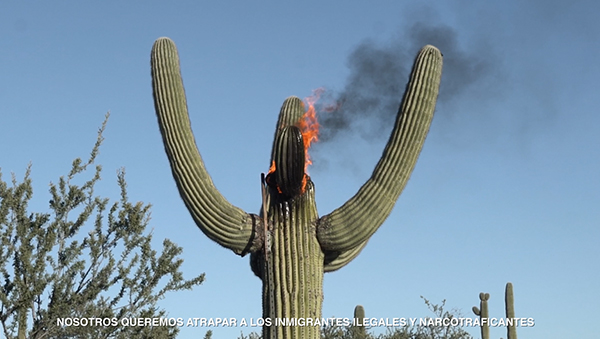
Miguel Fernández de Castro. Grammar of Gates, 2019. Video, 20’ 31’’. Presented by Ballroom Marfa, Texas (EE.UU.)
Miguel Fernández de Castro’s video Grammar of Gates / Gramática de las puertas is a dynamic visual and aural collage that traces the overlapping territories, languages, and conflicts that mark the border between Mexico and the U.S. within the sovereign Tohono O’odham Nation. The artist weaves together excerpts from the 1970 movie Geronimo Jones with drone and surveillance-like imagery of the landscape and an affectless recitation of phrases out of A Practical Spanish Grammar for Border Patrol Officers. The rote repetition from the textbook sets a backdrop for the banal and brutal architectures of power situated at the border. Via this military mantra the video registers who navigates the territory, legally and illegally, and the various physical and invisible barriers they might face. The artist uses an observatory set on a sacred mountain and a blocked gate meant to connect ancestral O’odham lands, as indices of the degradation of stewardship and access. Carefully grafting disparate source material, de Castro illustrates the language of power that defines the edges of a violent dynamic that in turn defines the border.
Miguel Fernández de Castro (Sonora, 1986) is a visual artist whose work examines how extractive and criminal economies materially transform a territory. Through long-term projects he has developed a body of work through photography, video, sculpture, archives and writing. His work has been shown at Frac Centre-Val de Loire, Orleans; e-flux, New York; Museo de Geología, UNAM, Mexico City; Spazio Veda, Florence; The Wren Library, Cambridge; Museo Artium, Vitoria; Proyecto Paralelo, Mexico City; Casa del Lago, Mexico City; Ashkal Alwan, Beirut; Museo de Arte Moderno de México, Mexico City; Museum of Anthropology, Vancouver; Bikini Wax, Mexico City; Museum of Latin American Art, Los Angeles; among others. Recently, he has been resident at PAOS, Guadalajara and at Casa Gallina-InSite, Mexico City.
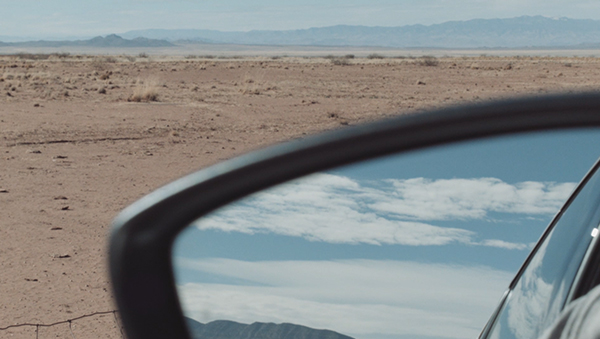
Lisa Tan. My Pictures of You, 2017-2019 (Mis fotos de vos). Video HD, sonoro, 23’. Seleccionado por Bonniers Konsthall, Estocolmo (Suecia)
The artist thinks of the images of Mars as a death mask of Earth captured millions of years in the future yet witnessed in the present. Compelled by photographs from NASA’s expeditions depicting Mars’ topography, Tan senses how the planet’s dry lake beds, undulating sand dunes, and horizon could be our own. Their striking familiarity transports her to the desert terrain of the American Southwest where she was raised. She bounces her poetic speculation off of a scientist responsible for key instruments gauging water and atmosphere on Mars.
A road trip through the desert frames questions around climate and extinction. Yet the deeper concern is with unraveling photographic meaning in relation to the Mars images, through the artist’s alternative analysis of Roland Barthes’ Camera Lucida. Barthes’ seminal text on photography pivots around an image of the author’s deceased, beloved mother as a child in what is known as the Winter Garden photograph. My Pictures of You offers a thought-experiment: replace Barthes’ mother for “mother” Earth. Despite the video’s bleak terrain it manages to transform its own pessimism into a joyful affirmation of earthbound existence.
Lisa Tan was born in 1973 in Syracuse, NY, USA, Lisa Tan lives in Stockholm where she is Professor of Fine Art at Konstfack University College of Arts, Crafts and Design. She works with video, photography, text, and installation. Tan is concerned with the ways in which images and language shape political consciousness, the formation of individual subjectivity, and desire. Aspects of her everyday life—such as love, experiences of otherness, loss—have all served as inspiration alongside her research into different fields of study such as theory of photography, literature, and affect.
Lisa Tan is currently included in osloBIENNALEN First Edition 2019-2024 with a work titled, Other Artists (2019). Recent exhibitions include a solo exhibition at Kunsthall Trondheim (2017), and the group exhibitions, An Inventory of Shimmers, MIT List Center (2017), Show and Tell, Malmö Konstmuseum (2017), Why Not Ask Again?, 11th Shanghai Biennale (2016), Decent, ICA Philadelphia (2016), Surround Audience, Triennial exhibition at the New Museum (2015). Her work is included in the public collections of Moderna Museet, Stockholm, Malmö Konstmuseum, the City of Oslo’s public art collection, and Coleção Moraes-Barbosa, São Paulo.
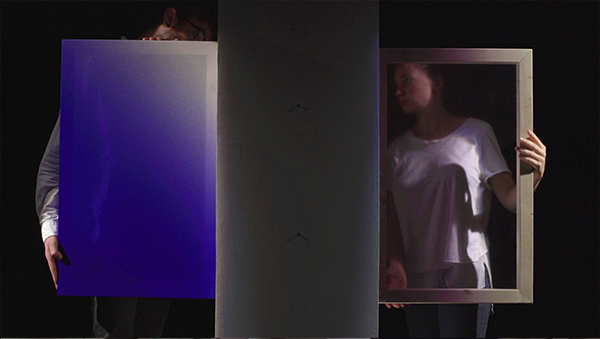
Filmic reality takes shape through words: a visual imagery created by the eloquent use of words and the construction of verses, but also via the development of a plot, that sequence of actions that the artist/director evokes to give a retinal form to images.
In language, the image of what surrounds us is a linguistic image, and this allows the artist-audience interaction; the video reminds us that language is a powerful tool mediating between us and the surrounding reality.
At the center of a dark space, the camera’s anticlockwise rotation around a column marks the rhythmic succession of a series of abstract images. As lines connecting dots spread around a sheet of paper, trajectories, colours, shapes and volumes seem to materialise fragments of an unknown alphabet, a silent and symbolic language. Meanwhile, in what seems to be a divinatory process, a voice over uses these very same fragments to propose starting points for futures stories.
Developed from a live performance, the film employs an abstract narrative to imagine six possible constellations that take shape in that space created between the narrator, the actors, the props and the dark of the night.
Francesco Pedraglio is interested in storytelling as a tool to decode intimate encounters with both mundane and historically complex situations. He looks at how the process of narrating and staging—oneself, or a situation—influences the relationship between teller and listener, making visible the fantasies and fictions that constitute our reality. The starting point of Pedraglio’s practice—being performance, sculpture, installation, prints, films—is writing. A curious detail, an overheard rumour, a banal incident, anything could spark some telling. And it’s in the movement from the written text to the live action, from the live action to a staged installation or a film that the exploration of language, fiction and reality-making occurs.
Francesco Pedraglio was born in Como (Italy) in 1981. He lives in Mexico City.
Dominka Olszowy. Wanda Wanton, 2016
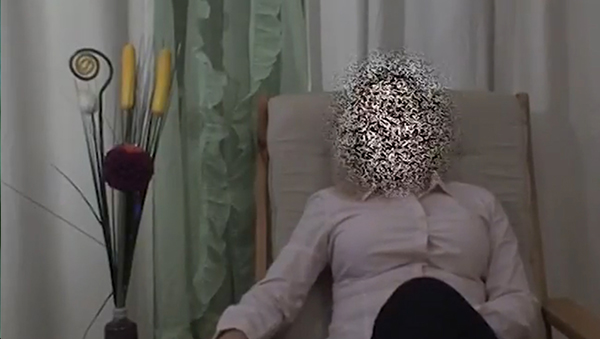
Dominka Olszowy. Wanda Wanton, 2016. Video, 9’14’’. Presented by Museum of Modern Art, Varsovia (Polonia)
Wanda Wanton, the lead character, is an aspiring artist from Wieliczka, working as a teacher of polish language. After work, Wanda devotes herself to a peculiar passions: she just loves to destroy things, and calls her acts of vandalism “acts of art” or simply “sculptures”. Vandalism becomes her life philosophy: destruction creates new order, therefore all creation has to be based on destruction. Wanda Wanton can be seen as an alter ego of Dominika Olszowy. By bringing her to life, the artist expresses her socially unacceptable desires. However, “Wanda Wanton”, first and foremost, casts a spotlight on the relationship between human and the surrounding matter, and asks a question: can vandalism be an act of emancipation, freeing an individual from the oppression of the enforced order?
Dominika Olszowy, b.1988 in Skwierzyna, Poland. Graduated with a BFA in Media Art from the University of Arts in Poznań, Poland. Her practice is located on the crossroads of various media – including video, performance, installation, set design and a unique mix of truth and fabrication. Olszowy draws from both form and aesthetics of amateur theatre, cabaret, mockument or talk show, mixed and exaggerated. Olszowy creates works, which she sometimes treats as amulets that swearing and tame reality in crisis.
In her work she is often based on personal experience. However, processes them in a universal, full of subtle humor statements about the human condition and time.Founder of ephemeral Sandra Art Gallery (since 2008), co-founder of a hip hop group Cipedrapskuad and a moped gang Horsefuckers M. C. Apart from her individual practice, Olszowy often collaborates with theatre directors creating set design. Lives and works in Warsaw.
Raqs Media Collective. Passwords for Time Travel, 2017.
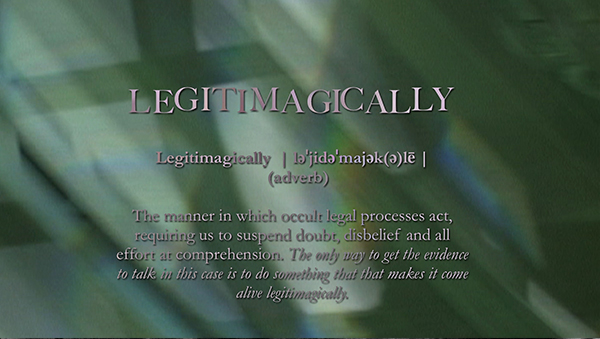
Raqs Media Collective. Passwords for Time Travel, 2017. (Contraseñas para un viaje en el tiempo) Video, 10’01’’. Seleccionado por Project 88, Mumbai (India)
Passwords for Time Travel consists of a suite of text and image videos that propose a set of terms that anticipate and rehearse conversations with the near and distant future. Combining the enigma of a spell with the precision of a dictionary entry, these unexpected lexical combinations are presented along with images that elaborate upon the multiple meanings of the texts.
Raqs Media Collective, Founded 1992, Based in New Delhi, India
Monica Narula, Shuddhabrata Sengupta, and Jeebesh Bagchi formed Raqs Media Collective in 1992, after they passed out of the AJK Mass Communication and Research Center, Jamia Milia University in Delhi while working together on their first, now lost, 16mm film, Half the Night Left, and the Universe to Comprehend.
Raqs Media Collective follows its self-declared imperative of ‘kinetic contemplation’ to produce a trajectory that is restless in its forms and exacting in its procedures. Raqs articulates an intimately lived relationship with time in all its tenses through anticipation, conjecture, entanglement and excavation. Conjuring figures of cognitive and sensory acuteness, Raqs’ work reconfigures perceptional fields and demands that everyone looks at what they take for granted, anew.
Raqs has exhibited widely, including at Documenta, the Venice, Istanbul, Taipei, Liverpool, Shanghai, Sydney and Sao Paulo Biennales. Recent solo exhibitions (and projects) include – Pamphilos at Fast Forward Festival 6, Athens (2019); Still More World at Arab Museum of Modern Art, Doha (2019); Twilight Language at Manchester Art Gallery (2017-2018); Everything Else is Ordinary at K21 Museum for 21st Century Art, Dusseldorf (2018); If It’s Possible, It’s Possible, MUAC, Mexico City (2015) and Untimely Calendar at the National Gallery of Modern Art, Delhi (2014-2015). Exhibitions curated by Raqs include In The Open or in Stealth (MACBA, Barcelona 2018 - 2019); Why Not Ask Again (Shanghai Biennale 2016-2017); INSERT2014 (New Delhi, 2014) and The Rest of Now & Scenarios (Manifesta 7, Bolzano, 2008). They are the artistic directors of the forthcoming Yokohama Triennale (2020).
Raqs continue to be anchored in Delhi, persistently welding a sharp, edgily contemporary sense of what it means to lay claim to the world from the streets of that city. At the same time, Raqs articulates an intimately lived relationship with myths and histories of diverse provenances. Raqs sees its work as opening out the possibility of a conversation that embodies a deep ambivalence towards modernity and a quiet but consistent critique of the operations of power and property.
Mohamed A. Gawad. Betalpha (Balbalah), 2018
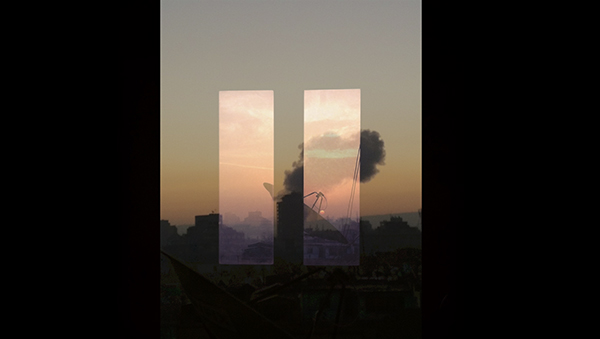
Mohamed A. Gawad. Betalpha (Balbalah), 2018. Video monocanal, sonoro. 5’31’’. Seleccionado por MMAG Foundation, Amman (Jordania)
Bal-balah, noun. 1- Befuddlement; Clutter; Discomposure. 2- A language
deconstruction exercise, where sentences of different linguistic origins morph through different mother tongues/ ears. 3- A hypothetical situation of a post-historic moment of loss of language: “At a time before time, a Big Bang in Babel sat the uni-logos into a perpetual process of language breeding. At one point, that expansion expires. What follows is a recoil; where dialect-ic-s coalesce, and separates overlap.”
Mohamed A. Gawad is a filmmaker and an editor based in Cairo. He holds an MFA in
scriptwriting and editing from RSICA. His works were screened in several festivals and spaces including Berlinale, Internationale Kurzfilmtage Oberhausen, Shnit Film Festival, Contemporary Image Collective - Cairo, and Les Instants Vidéo Numériques et poétiques. He is also a co-founder of Cimatheque – Alternative Film Center.
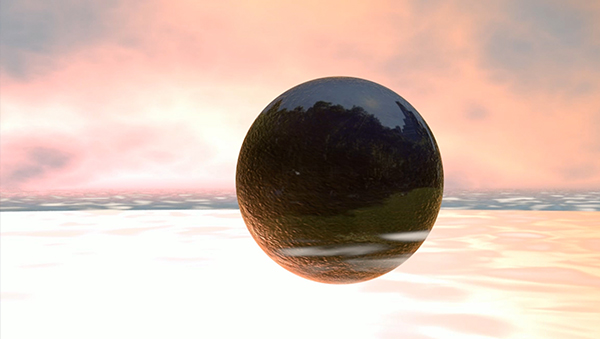
Yu Guo. Jiéjiè (Encantamiento), 2019. Video with sound. 12’57’’. Presented by KWM artcentre, Beijing (China)
‘jiéjiè’ is a buddhist word describing the protective ‘zone’ created through a collective consciousness among a group of people. Yu Guo takes this notion as a perspective through which to look at how we communicate within heavily mediated urban environments. For Yu Guo in today’s urban life, every single visual action of viewing functions like a screen constantly producing new narratives to follow or not. Watching a subway window is the same as watching one’s phone screen; both containing a kind of mediated language embedded inside. “jiéjiè ” is the screen where the two-way rendering of body and media communicate. The film aims to discuss how “jiéjiè’ works in this new environment and whether a new language is needed to describe this situation.
Born 1983 in Tongjiang, Sichuan Province, Yu Guo graduated from No.1 studio of Sichuan Fine Arts Institute, Chongqing, China in 2006. Currently lives in Chongqing, China. Yu Guo is fond of using concise content to depict obscure environments. The subject of each painting is clear, with few elements, and the works appear both extremely silent and bursting with concealed currents. While one can quickly recognize the structure of the works, they can’t help to observe every detail and begin to consciously edit out strange circumstances. Yu’s use of colors is also bright, and the contrasty riotous colors and quiet images create a striking contrast, making the paintings transparent but also opaque. This opacity is not in the visuals or mood. It stems from the perceptual experience of their obscure settings, accompanied by the quiet and mystery that could be broken at any moment. This control over the composition may stem from Yu Guo’s unawareness of his nature, or the discordant effect that he creates by design or accident. This immediate sense of different layers is the first impression we receive upon viewing his paintings.
Evgeny Granilshchikov. Courbet's Funeral (El funeral de Courbet), 2014
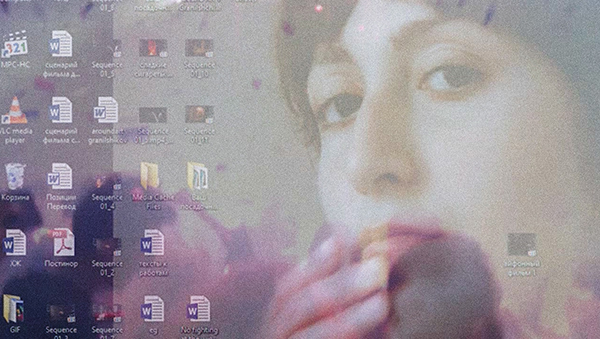
Evgeny Granilshchikov. Courbet's Funeral (El funeral de Courbet), 2014. Video monocanal recorded with cellphone, 11’33’’. Selected by Moscow Museum of Modern Art.
The video is composed of mobile phone footage, recorded from February to April 2014. It explores our recent political history: the period of the emerging protests against the war in Ukraine, the ongoing Bolotnaya Square case, and the time just preceding the economic crisis. The work captures the moment of anxiety and uncertainty about our nearest future, with the semi-documentary recordings of simple, everyday life reminding one of hopes indefinitely suspended in the air.
Courbet’s Funeral is a collage, blending video poetry with documentation, fiction with reality and politics, and creating multilayered associations rooted in personal and national histories. The film has preserved the tense and slightly dreamy flow of life characteristic of those times, which ultimately gets dissolved in the pink lights of the final party scene – unfolding to the soundtrack of the band Motherfathers.
Evgeny Granilshchikov (b.1985, Moscow, Russia) lives and works in Moscow. He graduated from the Moscow Institute of Journalism and Literature in 2009, and the Rodchenko Moscow School of Photography and Multimedia in 2013. Solo exhibitions include: Untitled (After Destructions), Multimedia Art Museum, Moscow (2016); and Rehearsal Time, Triumph Gallery, Moscow (2013). Group exhibitions include: One Within the Other: Art of New and Old Media in the Age of High-speed Internet, Moscow Museum of Modern Art (2016); 6th Moscow Biennale of Contemporary Art (2015); Borderland, GRAD, London (2015); Burning News, Hayward Gallery, Southbank Exhibition Center, London (2014); 4th Moscow International Biennale for Young Art, Museum of Moscow (2104); 11, Garage Museum of Contemporary Art, Moscow (2014); and Happy End, Multimedia Art Museum, Moscow (2013). He has been awarded the Open Frame Award (Germany, 2016) and the Innovation Prize (Russia, 2013 and 2015).
Yao Qingmei. Sanzu Ding and its Patterns: A major archeological discovery (Sanzu Ding y sus patrones: Un gran descubrimiento arqueológico), 2013-actuality.
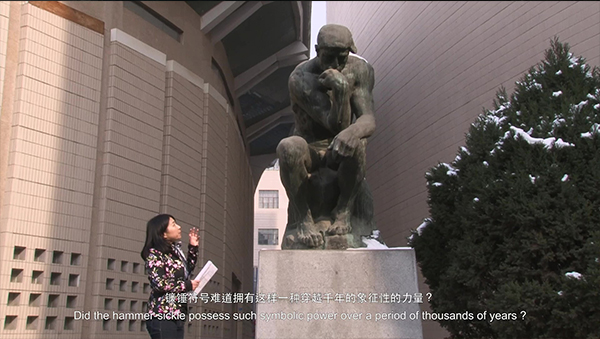
Yao Qingmei. Sanzu Ding and its Patterns: A major archeological discovery (Sanzu Ding y sus patrones: Un gran descubrimiento arqueológico), 2013-actulalidad. Video, 8’ 12’’. Cortesía del artista, edición especial AFI, 2020. Seleccionado por Para/Site Art Space (Hong Kong)
Professor Yao has been extensively researching on the archaeological subject of 'Sanzu Ding and its Motifs' over a yearlong period. The ‘Sanzu Ding’, more commonly used as a ritual pottery vessel, was unearthed by archaeologists in 2013 and bears a mysterious symbol uncannily similar to the hammer and sickle of modern communism. Carbon-14 dating showed it had been made around 3000 BC during the Neolithic period. Professor Yao, a specialist in ancient Chinese ideograms, presents six hypotheses on the origins and evolution of this symbol based on her extensive research in archaeology, semiology, and psychoanalysis. 'Professor Yao' is a fictional character played by the artist. Some of the works cited in the research are files forged and mined from research artifacts.
The formation of the fictional character 'Professor Yao' has unfolded through a series of performances. The work stemmed from an initial series of performative lectures held in universities and art centres across China, France, and Germany. Embodying the authoritative role of an invited academic, Professor Yao unveiled her research to an audience of unsuspecting students. In later stages within an exhibition context, the research has expanded and grown into a constellation of media and records comprising photographs, lightboxes, ceramic objects, printed text, and video installation, displayed in the manner of a museum collection.
Yao Qingmei (b.1982, Wenzhou, China) currently lives and works in Wenzhou, China and in Paris, France. She received her DNSEP with honours from Villa Arson, Nice, France in 2013, and was the winner of Prix spécial du jury at the 59th Salon de Montrouge in 2014, the Young Chinese Artist of the Year Prize in 2017, and the Prix Jeune Création of Paris in 2018.
Yao’s practice traverses the boundary between performance and its site, frequently enacting interventions in public spaces to perturb the parameters of their reality and surroundings. Her artistic practice is deeply rooted in a critical reflection into the formulation of political and social discourses, exploring how symbolic gestures gain or lose power through forms of appropriation and displacement. Humour, which is constantly employed to expose absurdity, plays an important role in her work. Offering different methods of resistance, her theatrical performances and interventions are realised in the overlapping burlesque traditions of satire and parody, combined with framing devices influenced by theatre sets and costume, pedagogical lectures, the dialectic between image and text, and choreography inspired by modern dance.
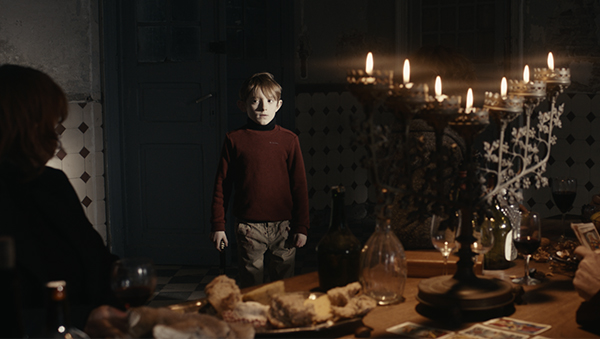
Ergin Çavuşoğlu. Desire Lines (Tarot & Chess), 2016 [Líneas de deseo (Tarot y ajedrez)]. Video monocanal HD, audio, 29’3’’ © Ergin Çavuşoğlu. Cortesía del artista, Extra City Kunsthal, Platform 0090 yFLACC. Producido con el apoyo de SAHA, Estambul.
Desire Lines are broadly paths of will that represent the search for the shortest navigational route between an origin and destination. This work reveals the universal patterns of human behaviour and their relationship to past, present and future observed through the prism of literary expressions articulated by Italo Calvino in his book The Castle of Crossed Destinies (1973). The characters in the film are loosely based on the ones in the Marseille set of tarot cards that are faithfully portrayed by Calvino, but nevertheless they have all been assigned new roles in accordance with the different cinematographic treatment of the narrative. Calvino’s book portrays an encounter of travelers who tell their adventures (or whose adventures are told for them) using tarot cards instead of words. The interpretations of the cards in the book allude to classic tales such as Faust, Oedipus, and Shakespearian narratives such as Hamlet, Macbeth and King Lear. The mixture and the striking contrast between history and contemporanity in the storyline and the characters lend themselves to simultaneously present the narrative in a linear fashion, as well as in a more abruptly multivalent ways, thus interpreting scenes that happen across time and place in an absurd harmony.
Ergin Çavuşoğlu (Bulgaria) studied at the National School of Fine Arts, Sofia, Marmara University (BA) Istanbul, Goldsmiths College (MA) London, and the University of Portsmouth (Ph.D). Çavuşoğlu co-represented Turkey at the 50th Venice Biennale in 2003. He was shortlisted for the Beck’s Futures Prize in 2004 and for Artes Mundi 4 in 2010.
Central to Çavuşoğlu’s practice are concepts and themes that probe the notions of place, liminality and the conditions of cultural production, which he has been exploring through a range of media, including video and sound installations, painting, sculpture and anamorphic drawings.
Çavuşoğlu has had solo exhibitions at Extra City Kunsthal, Antwerp (2016), PEER, London (2010), Ludwig Forum für Internationale Kunst, Aachen (2009), Kunstverein Freiburg (2008) and John Hansard Gallery, Southampton (2006), among others. Museum and biennial exhibitions include, Galleria d’Arte Moderna Milano (GAM) (2018), MacKenzie Art Gallery, Regina (2018), The Jewish Museum and Tolerance Center, Moscow (2018), Es Baluard Museum of Modern Art, Palma (2017), Solomon R. Guggenheim Museum, New York (2016), Istanbul Modern, Istanbul (2015), Manifesta 8, Murcia (2010), Zentrum Paul Klee, Bern (2009), Schirn Kunsthalle, Frankfurt (2008), the British Art Show 6 (2005), ICA, London